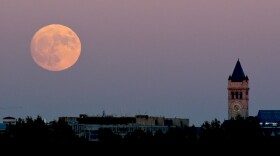-
The best time to catch the meteor shower will be after midnight into early Wednesday.
-
A bright moon will make it hard to see the Perseid meteor shower in mid-August, but Tuesday night offers a decent chance of seeing some shooting stars.
-
This phenomenon, known as a "planet parade," will feature Mercury, Venus, Mars, Jupiter, Saturn, Uranus and Neptune all present at the same time along a line in the night sky, NASA says.
-
NASA estimates about 50 to 100 meteors can be seen per hour as the Earth passes through the dusty trail left behind by the comet Swift-Tuttle.
-
Saturday's partial eclipse caused some shadows on the ground to look like crescents, or mini-moons.
-
June's full moon gets its nickname from the strawberry harvesting season in the Northeastern U.S. It also happens to be at its closest distance to Earth in its orbit, which makes it a supermoon.
-
South America and much of the continental United States had the best view of Sunday night's lunar eclipse, which lasted nearly five hours.
-
Over the past year or so, local governments across the Big Bend have adopted stricter outdoor lighting rules, part of a broader effort to protect the region’s famously starry night skies.
-
As they count down the hours to the highly anticipated launch of NASA's powerful, $10 billion James Webb Space Telescope, astronomers hope for the best while fearing the worst.
-
The "Super Flower Blood Moon" is happening early Wednesday morning, as a supermoon coincides with a full lunar eclipse. Here's how to see it.
© 2025 KUT Public Media
A service of the Moody College of Communication at the University of Texas at Austin
webmaster@kutx.org
A service of the Moody College of Communication at the University of Texas at Austin
webmaster@kutx.org
Play Live Radio
Next Up:
0:00
0:00
Available On Air Stations










